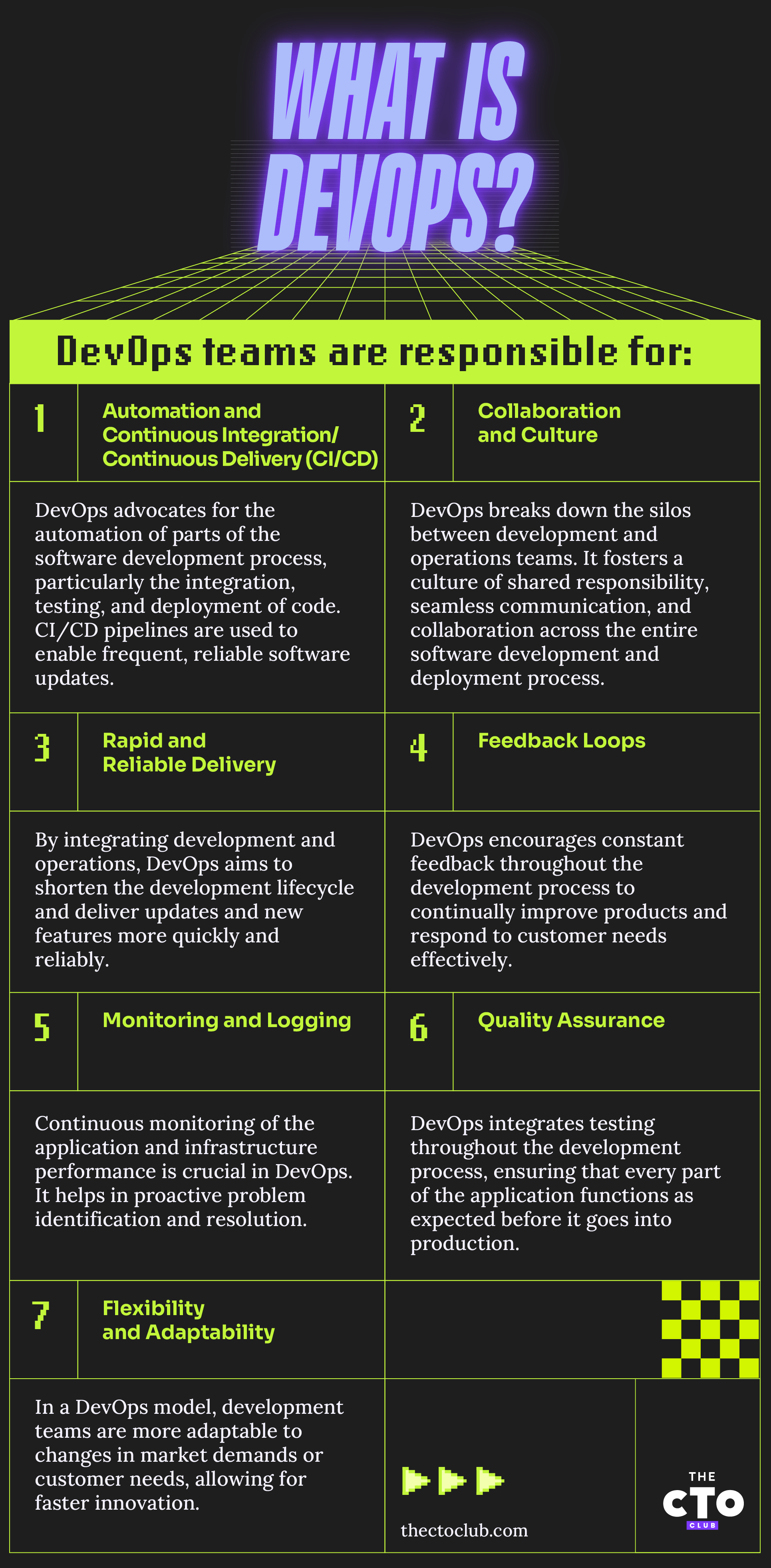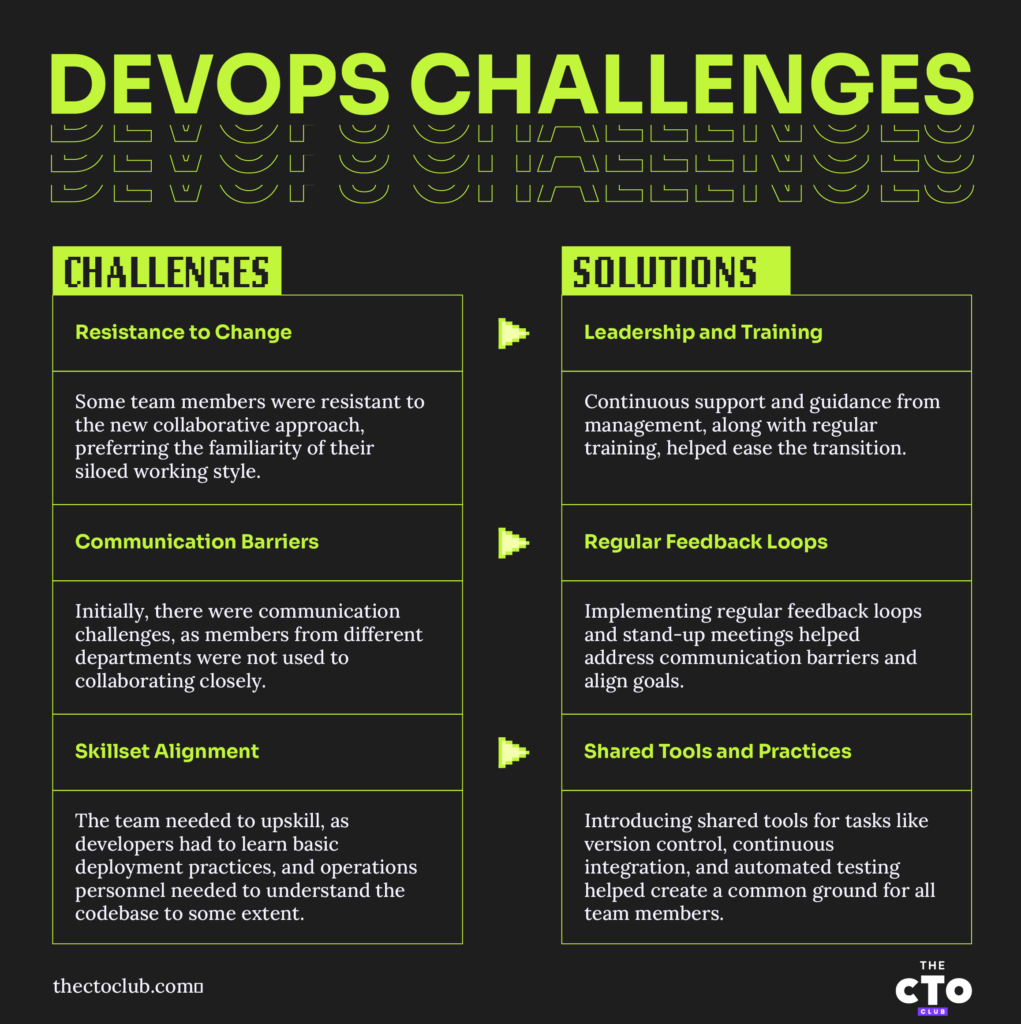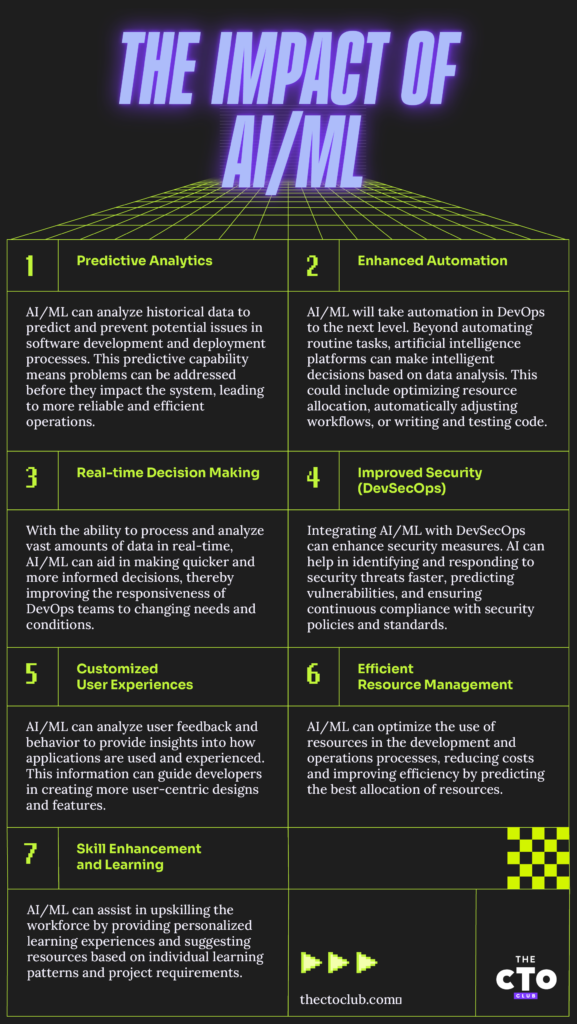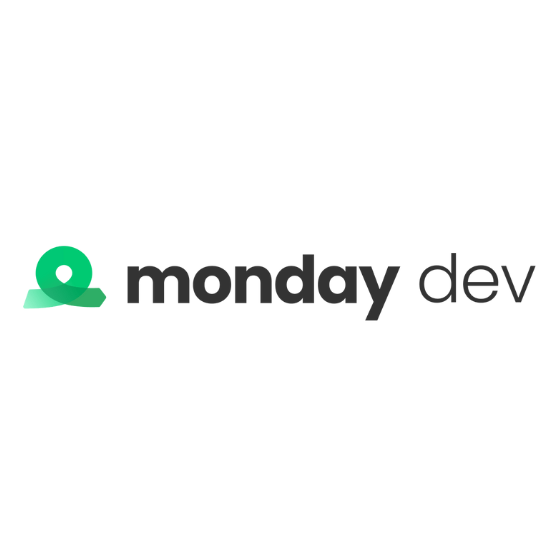DevOps is a collection of practices, tools, and cultural philosophies designed to automate and synchronize the workflows of software development and IT teams.
Leading organizations, such as Microsoft, Amazon, and Netflix, leverage DevOps practices to achieve remarkable results. According to the DORA State of DevOps Report, elite performers deploy code over 200 times more frequently than low performers and recover from failures over 20 times faster, , creating a substantial competitive advantage.
Whether you're a CTO seeking to transform your development process, an IT manager aiming to enhance efficiency, or a developer looking to grasp the DevOps ecosystem, this definitive guide offers the insights and actionable strategies you need to succeed with DevOps implementation.
What You'll Learn
- What DevOps is and why it's transforming software development
- Core DevOps practices that drive efficiency and quality
- How to implement DevOps successfully in your organization
- Essential DevOps tools for each stage of the development lifecycle
- DevOps vs. traditional approaches - key differences and advantages
- Real-world case studies showing DevOps success metrics
- DevSecOps integration for robust security throughout the pipeline
- Future DevOps trends including AI/ML integration and NoOps
Let's explore the basics of this methodology, including DevOps tools, challenges, pricing for DevOps, and the benefits of adopting DevOps practices in your organization in this helpful guide.
What is DevOps? Definition & Core Principles
DevOps is a set of practices and philosophies that combines software development (Dev) and IT operations (Ops), aiming to shorten the systems development life cycle and provide continuous delivery with high software quality. It's an approach that emphasizes collaboration, communication, and integration between developers and IT professionals.

Why is DevOps Important?
DevOps is crucial because it bridges the gap between development and operations, fostering a culture of collaboration and efficiency. This integration leads to faster deployment of features, enhanced innovation, and improved product quality.
By automating repetitive tasks and implementing continuous integration and delivery (CI/CD), DevOps not only increases operational efficiency but also ensures more reliable and stable software releases.
Furthermore, its customer-centric approach aligns closely with business objectives, leading to higher customer satisfaction and better market responsiveness. In essence, DevOps is a key driver in creating more agile, responsive, and efficient IT environments.
-

monday dev
Visit WebsiteThis is an aggregated rating for this tool including ratings from Crozdesk users and ratings from other sites.4.6 -

QA Wolf
Visit WebsiteThis is an aggregated rating for this tool including ratings from Crozdesk users and ratings from other sites.4.8 -

Site24x7
Visit WebsiteThis is an aggregated rating for this tool including ratings from Crozdesk users and ratings from other sites.4.6
DevOps Practices
Dev operations teams are responsible for end-to-end software lifecycles. They often work long-term with stakeholders and end-users to create products and continuously improve those solutions as business needs grow and change. DevOps best practices, such as automation and continuous integration, are critical in these efforts.
- Automation and CI/CD: Continuous integration is a software deployment process that worries less about version control and more about continuous improvement to support end-users. It works like this:
- Individual developers work to make code changes in keeping with business requirements, Agile team direction, or other frameworks.
- Multiple times each day, developers merge their changes into the main branch. This amounts to multiple minor upgrades or changes instead of extensive updates delivered periodically.
- Every merge causes automations to launch. Automated testing sequences validate that the code changes are good and the merge is successful.
- Depending on the nature of the code changes, further software delivery automations might be triggered. In some cases, continuous delivery tools allow these updates to occur in real-time, deploying into production environments so users can enjoy new features immediately.
Whether new features are slowly integrated into live environments in this manner or deployed via daily updates or on an anticipated "release delay" depends on the DevOps team's overall approach, the environment they're working in, and the nature of the code changes being made. Teams must also use platforms like Travis-Cl or Jenkins for continuous integration.
- Collaboration and Culture: DevOps breaks down the silos between development and operations teams. It fosters a culture of shared responsibility, seamless communication, and collaboration across the entire software development and deployment process.
- Rapid and Reliable Delivery: By integrating development and operations, DevOps aims to shorten the development lifecycle and deliver updates and new features more quickly and reliably.
- Feedback Loops: DevOps encourages constant feedback throughout the development process to continually improve products and respond to customer needs effectively.
- Monitoring and Logging: Continuous monitoring of the application and infrastructure performance is crucial in DevOps. It helps in proactive problem identification and resolution.
- Quality Assurance: Many teams use tools such as JUnit and Selenium to support the automation of testing and QA processes. In DevOps practices, automated testing is pivotal for enhancing quality assurance, allowing for frequent and reliable testing throughout the software development lifecycle. This automation not only speeds up the delivery process but also ensures a higher standard of product quality, reducing errors and improving overall software performance.
- Flexibility and Adaptability: The flexibility of remote work enhances the agility and responsiveness of DevOps practices, further breaking down geographical barriers and fostering a more connected, global approach to development and operations. Post-pandemic development teams are much more likely to work remotely than on-premises.
- While there are plenty of collaborative task and project management software solutions available, allowing teams to track the DevOps pipeline and application lifecycle even when working remotely, a DevOps culture is inherently collaborative. Distributed teams working different schedules can face challenges when upholding the tenets of DevOps methods.
- The Harvard Business Review lists common remote and hybrid work challenges, including coordination, connection, communication, and culture obstacles. These challenges can be overcome with commitment from leadership and team members, creative approaches, and proven remote working tools.
Other essential practices include continuous monitoring, continuous deployment, and the concept of using Infrastructure as Code (IaC) to automate the provisioning of cloud services. Open-source containerization tools, such as Docker, are often used, along with Kubernetes, orchestration tools like Puppet, and cloud computing platforms like Amazon AWS or Microsoft Azure.
Overall, DevOps represents a shift in the way organizations build, test, and release software, focusing on a fast and efficient development lifecycle that emphasizes automation, collaboration, and continuous improvement.
Mobile DevOps: Extending Principles to App Development
DevOps practices have evolved to address the unique challenges of mobile application development. Mobile DevOps isn't simply a branch of traditional DevOps but rather an extension that adapts core DevOps principles to the specific requirements of mobile development environments.
How Mobile DevOps Differs
DevOps teams working on mobile applications face distinct challenges that traditional web or server application development doesn't encounter:
- Device fragmentation across multiple operating systems, manufacturers, and screen sizes
- App store approval processes that add additional verification steps
- Over-the-air update limitations that affect deployment strategies
- User experience considerations unique to mobile interfaces
- Battery and performance optimization requirements
These challenges require DevOps teams to adapt their practices while maintaining the core philosophy of collaboration, automation, and continuous improvement.
Mobile DevOps Practices
DevOps teams implement specialized practices for mobile app development:
- Automated testing across multiple device profiles and operating system versions
- Continuous integration systems that build for multiple target platforms
- Beta distribution channels for pre-release testing with real users
- Crash and analytics monitoring specific to mobile environments
- Release management that accommodates app store approval timelines
These adaptations help DevOps teams maintain rapid delivery cycles despite the additional complexity of mobile environments.
Tools Supporting Mobile DevOps
Several tools have emerged to support DevOps practices in mobile development. These include cloud-based device farms for testing, specialized CI/CD pipelines for multiple target platforms, and mobile-specific monitoring solutions. These tools help DevOps teams overcome the unique challenges of mobile development while maintaining efficiency and quality.
By implementing Mobile DevOps practices, organizations can achieve the same benefits of traditional DevOps — faster delivery, higher quality, and improved collaboration — in their mobile application development processes.
DORA Metrics: The Gold Standard for DevOps Performance
DORA metrics, developed by the DevOps Research and Assessment team, provide the industry standard for measuring software delivery performance. These four key metrics help organizations evaluate and improve their DevOps practices:
The Four Key DORA Metrics
- Deployment Frequency: How often code is successfully deployed to production
- Elite performers: Multiple deployments per day
- Low performers: Between once per month and once every six months
- Lead Time for Changes: Time from code commit to production deployment
- Elite performers: Less than one hour
- Low performers: More than six months
- Mean Time to Recovery (MTTR): Time to restore service after a failure
- Elite performers: Less than one hour
- Low performers: More than one week
- Change Failure Rate: Percentage of deployments causing production failures
- Elite performers: 0-15%
- Low performers: 46-60%
Historical Context
First published in the 2016 State of DevOps Report, DORA metrics emerged from research studying thousands of teams across various industries. The metrics have evolved through continued research, with annual reports showing the widening performance gap between elite and low performers.
Practical Applications
These metrics, when applied appropriately and within relevant context, facilitate insights into DevOps performance, enabling teams to:
- Identify bottlenecks in delivery pipelines
- Balance speed and stability
- Track improvement over time
- Compare against industry benchmarks
- Make data-driven decisions to enhance software development processes
Organizations at any stage of DevOps maturity can use these metrics to establish baselines, set realistic targets, and measure progress on their continuous improvement journey.
How DevOps Works
Gaining buy-in from everyone, including development teams, DevOps engineers, and business leaders, is crucial to the success of a DevOps culture. Practically, however, it works in software development via well-controlled phases:
- Planning: During this phase, DevOps teams collaborate closely with business partners and other stakeholders to determine the necessary requirements. They may create business requirements documents, project or comprehensive tech roadmaps, and plans for future development. Planning is typically conducted on a broad, high-level basis once or more per year, and on a project-by-project or product-by-product basis for specific developments.
- Coding: Next, the dev team begins coding. They may collaborate via tools like Git and use open-source and shared resources to drive efficiencies.
- Building: If coding creates the bricks used to build products, this stage involves piecing them into their final form.
- Deploying and Testing: The overall product is deployed to a dev environment for testing. DevOps teams that leverage continuous integration and delivery may deploy new features and updates direct to live environments after automated testing.
- Releasing: New software, apps, and significant updates may be handled via a formal release, while more minor updates are managed via continuous integration tools.
- Operating: Once a technology is in use by operations teams, tech teams fall into a support role. They continue to monitor metrics regarding product performance if applicable and may proactively launch the DevOps phases to address any challenges.
During each step of the DevOps pipeline, continuous monitoring allows DevOps personnel to observe and detect security threats or compliance issues.
How DevOps Differs from Traditional IT Approaches
In a traditional IT environment, deployments are infrequent. The waterfall development method means big batches and high-risk releases. This creates a culture where people are scared of failing.
The traditional IT development model creates skills silos. Each team has poor visibility into the role of the other teams. Specialists are focused purely on getting their part of the job done because the metric for success for their team is completing that specific job. The DevOps model changes this. Smaller deployments, automated testing, and microservices make it easier to produce higher-quality software products on a faster release cycle with less downtime.
DevOps Methods
DevOps monitoring tools and methods were created — and continue to be updated — based on preexisting technology methodologies.
Agile Methodology
Agile and related Scrum frameworks provide iterative processes that rely on feedback from end-users and fast, flexible coding work. Tech organizations that use Agile software development tools are responsive to change and can develop software and applications on shorter timelines than traditional approaches.
The efficiency wins of Agile are significant in DevOps because organizations typically still want this level of responsiveness. DevOps takes the streamlined approach while wrapping it in a more controlled and enterprise-appropriate structure.
Other Methodologies
DevOps teams also adopt other project management methodologies and tools, including Lean approaches and Kanban workflows.
Lean production environments focus on efficiency and the elimination of waste. This is clearly evident in the DevOps principle of sharing. Lean management looks to reduce rework, for example. In DevOps, once a skill or knowledge is acquired, it's never held within a single team. The information is put into a repository and shared with others to support more efficient development.
Kanban features often affect this type of lean, team approach to development efforts. This framework enables DevOps teams to communicate in real-time, promote transparency in their work, and easily identify where efforts are or need to be, thanks to visual workflow views.
GitOps Methods
DevOps teams now embrace GitOps as a specialized approach to managing infrastructure and application deployments. GitOps leverages Git repositories as the single source of truth — a natural extension of DevOps practices many teams already follow.
GitOps works by treating infrastructure the same way developers treat application code. When a team implements GitOps:
- All infrastructure configurations are stored in Git repositories
- Changes to environments happen only after Git commits are approved
- Automated systems continuously sync the actual environment with the Git-defined state
- Rollbacks become as simple as reverting to a previous Git commit
This approach brings significant advantages to DevOps teams. Version control provides a complete history of every infrastructure change, making it easy to track who changed what and when. If a deployment causes problems, teams can quickly revert to a previous working state.
How GitOps Strengthens DevOps Practices
GitOps builds on existing DevOps skills, using the same Git workflows developers already know. This method provides better visibility into changes, improves collaboration between development and operations, and creates a built-in audit trail for compliance requirements.
The pull request process common in Git workflows naturally integrates security reviews and testing before changes reach production environments. This makes GitOps particularly valuable for DevOps teams focused on securing their deployment pipelines.
Tools like Flux and ArgoCD have emerged specifically to support GitOps workflows, providing the continuous synchronization capabilities needed to keep environments consistent with their Git definitions.
DevOps Challenges
Making the shift from a waterfall development approach to DevOps processes can be a challenge. Consider this example of a mid-sized software development company.
Background: The company, traditionally structured with distinct departments for software development, quality assurance, and IT operations, operated in silos. This siloed approach often led to delayed releases, miscommunication, and a lack of accountability when issues arose in the software deployment process.
The Challenge: The company adopted DevOps practices to streamline its software development and deployment processes. However, the cultural shift from working in silos to a collaborative, integrated team approach was significant. Developers were accustomed to handing off code to the operations team without considering deployment issues, while the operations team often found themselves firefighting problems without understanding the codebase.
Implementing Change: The transition began with joint workshops and training sessions to align all teams with the DevOps methodology. Cross-functional teams comprised members from development, operations, and quality assurance. These teams were tasked with end-to-end responsibility for specific modules of the project.

Challenges Faced:
- Resistance to Change: Some team members were resistant to the new collaborative approach, preferring the familiarity of their siloed working style.
- Communication Barriers: Initially, there were communication challenges, as members from different departments were not used to collaborating closely.
- Skillset Alignment: The team needed to upskill, as developers had to learn basic deployment practices, and operations personnel needed to understand the codebase to some extent.
Solutions:
- Leadership and Training: Continuous support and guidance from management, along with regular training, helped ease the transition.
- Regular Feedback Loops: Implementing regular feedback loops and stand-up meetings helped address communication barriers and align goals.
- Shared Tools and Practices: Introducing shared tools for tasks like version control, continuous integration, and automated testing helped create a common ground for all team members.
Outcome: Over time, the cultural shift took root. The integrated approach led to faster resolution of issues, more efficient deployment cycles, and a more cohesive work environment. The company observed a significant reduction in deployment times and an increase in the overall quality of its software products.
Challenging traditional working models requires a significant cultural shift, but with practical strategies and leadership, these challenges can be transformed into successful collaboration.
Security Concerns
In a DevOps environment where speed and efficiency are prioritized, security concerns can often be overshadowed, leading to potential vulnerabilities. To address this, DevSecOps has emerged to integrate security principles from the start of the development process.
DevSecOps ensures that security is not an afterthought, but a fundamental aspect of the entire development and operations lifecycle. This approach requires collaboration between development, operations, and security teams to identify and mitigate security risks proactively.
Implementing DevSecOps tools means that security becomes a shared responsibility, contributing to a more robust and secure end product without sacrificing the agility and speed that DevOps offers.
Ensuring Stakeholder Alignment and Buy-In
Some non-technical managers may still view DevOps as a cutting-edge methodology. To ensure stakeholder buy-in, highlight how effective DevOps can be at building business buy-in.
According to a report published by Google Cloud’s DevOps Research and Assessment, elite DevOps performers deploy code 208 times more frequently than low performers and have fewer change failures.
Highlighting these improvements in the context of your software release schedule helps stakeholders understand the business value this methodology can bring.
DevOps Pricing
DevOps tools vary widely in pricing, depending on the features, scalability, and level of automation they offer. Whether you're a small team just starting out or a large enterprise looking to optimize your pipeline, you'll want DevOps software that has the features your team needs.
- Jenkins is a popular open-source CI/CD tool, making it completely free for teams that want full customization.
- GitLab offers a free tier, with paid plans starting at $19 per user per month, and is ideal for teams seeking an integrated DevOps platform with issue tracking and CI/CD capabilities.
- CircleCI provides a free plan and paid options starting at $15 per month, offering flexibility in configuring CI/CD workflows.
- Azure DevOps offers a free plan for up to 5 users, with paid plans starting at $6 per user per month.
- AWS CodePipeline operates on a pay-as-you-go model, starting at $1 per active pipeline, making it a great option for teams using AWS.
- TeamCity and Atlassian Bamboo cater to larger enterprises, with pricing starting at $299 per year for TeamCity and $1,100 for Bamboo.
- Terraform by HashiCorp offers flexible pricing based on resource usage, starting at $0.03 per hour, ideal for managing infrastructure as code (IaC) in cloud environments.
What's Next for DevOps?
DevOps is maturing as a practice, but that doesn’t mean it’s stagnating. New ways of thinking, such as NoOps, where developers manage their own deployments, are being explored.
There’ll always be a need for project management, security, and operations departments, but giving developers more freedom when it comes to the provisioning of infrastructure and rolling tested builds out to a production environment could offer organizations a competitive advantage in terms of increased agility.
Automation with Infrastructure as Code (IaC)
Rapidly gaining momentum in the DevOps community (and a significant shift in how IT infrastructures are managed) is IaC – a practice where infrastructure is provisioned and managed using code and software development techniques rather than manual processes or interactive configuration tools.
Several key benefits from Infrastructure as Code tools that align well with the goals of DevOps include:
- Consistency and Standardization
- Speed and Efficiency
- Version Control and Documentation
- Error Reduction
- Cost-Effective Resource Management
- Enhanced Security and Compliance
- Scalability and Flexibility
- Disaster Recovery and High Availability
IaC is poised to become a fundamental component of IT infrastructure management, underpinning the automation strategies of organizations and driving efficiency, reliability, and agility in the DevOps landscape.
The Impact of AI/ML
The intersection of DevOps with AI and Machine Learning (ML) software will affect how software development and operations are conducted – making them more predictive, automated, efficient, and secure – ultimately leading to faster, more reliable, and user-centric software products.
This integration, termed AIOps (Artificial Intelligence for IT Operations), is expected to bring several transformative changes:

- Predictive Analytics: AI/ML can analyze historical data to predict and prevent potential issues in software development and deployment processes. This predictive capability means problems can be addressed before they impact the system, leading to more reliable and efficient operations.
- Enhanced Automation: AI/ML will take automation in DevOps to the next level. Beyond automating routine tasks, artificial intelligence platforms can make intelligent decisions based on data analysis. This could include optimizing resource allocation, automatically adjusting workflows, or writing and testing code.
- Real-time Decision Making: With the ability to process and analyze vast amounts of data in real time, AI/ML can aid in making quicker and more informed decisions, thereby improving the responsiveness of DevOps teams to changing needs and conditions.
- Improved Security (DevSecOps): Integrating AI/ML with DevSecOps can enhance security measures. AI can help in identifying and responding to security threats faster, predicting vulnerabilities, and ensuring continuous compliance with security policies and standards.
- Customized User Experiences: AI/ML can analyze user feedback and behavior to provide insights into how applications are used and experienced. This information can guide developers in creating more user-centric designs and features.
- Efficient Resource Management: AI/ML can optimize the use of resources in the development and operations processes, reducing costs and improving efficiency by predicting the best allocation of resources.
- Skill Enhancement and Learning: AI/ML can assist in upskilling the workforce by providing personalized learning experiences and suggesting resources based on individual learning patterns and project requirements.
-

RapidMiner
Visit WebsiteThis is an aggregated rating for this tool including ratings from Crozdesk users and ratings from other sites.4.6 -

Databricks
Visit WebsiteThis is an aggregated rating for this tool including ratings from Crozdesk users and ratings from other sites.4.5 -

iguazio
Visit WebsiteThis is an aggregated rating for this tool including ratings from Crozdesk users and ratings from other sites.4.8
Join for More Insights
DevOps offers a variety of best practices for software development processes that are critical to the success of SaaS companies. When your bottom line rests on how quickly and accurately you can bring products to market, it's worth investing in knowledge about practices that make your work more efficient and functional.
Subscribe to our newsletter for the latest insights for aspiring DevOps leaders.











